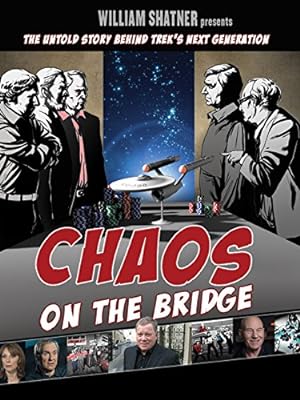William Shatner created Chaos on the Bridge, a documentary about how Star Trek: The Next Generation was made during its early years. It is only one hour long so if you even have a slight interest in the series, it is worth your time, but it may take several attempts to really grasp the substance of what is revealed about the production.
Chaos on the Bridge’s flashy graphics and Shatner’s reaction shots are meant to jazz up what would otherwise be one hour of talking heads. Shatner sees this chronicle through the lens of a poker game or the Wild West. He sees TV production as a struggle for power, sometimes life and death and other times like a poker game. Unfortunately the graphics don’t always match what the person being interviewed is actually saying so what you will absorb and remember largely depends on which sense you favor, seeing or hearing. I actually watched the documentary a couple of times once I realized why I was having a problem focusing on the film. It is a real shame that he used these illustrations because otherwise this documentary should be shown to anyone interested in working in TV, either the business and/or creative side. Shatner is an entertainer first then a filmmaker so I suppose that going for the gimmicks is forgiveable, but was completely unnecessary because the documentary was perfect without it.
Chaos on the Bridge does a great job of not trying to force the viewers into believing a single version of events and is comfortable placing conflicting stories side by side and allowing us to decide what really happened. If we could learn anything from this documentary (and Rashomon), people never think that they are lying, but interpret events from different perspectives. For example, in the discussion of what led to a writing credit conflict that had to be resolved in arbitration for the pilot episode, there are no fewer than three versions of what led to it, and there are probably more accounts, but Gene Roddenberry was dead when this documentary was made so we don’t really get his perspective though his assistant chimes in.
Because most of the people featured in Chaos on the Bridge are still well known and have gone on to work behind the scenes in other famous TV series, it is a real treat to see what they are like as people. John Pike, the former President of Paramount Network Television, was probably the happiest to finally get in front of the screen and was hamming it up in his stories about playing mind games with Roddenberry and Patrick Stewart. I would probably want to have lunch with Brannon Braga because he analyzed life like one of his stories and was interested in providing a more philosophical perspective on how the show’s development reflected Roddenberry’s evolution in his personal life. Maurice Hurley, the man who invented the Borg, was less of a Trekkie and more of a technician in his approach to getting the series more interesting to viewers, but he is also a bit of a character in the exuberant way that he relates his version of events.
Chaos on the Bridge really felt like it could have been longer. It is scattered throughout the documentary, but unlike the futuristic world it depicted, it appeared that women working on Star Trek: The Next Generation had more pitfalls than men. There was definitely a disparity in the way that their superiors received their work and punished them. I watched the series as a kid, but it never occurred to me before watching this documentary that all the regular cast members who left or were written out were women: Denise Crosby, Gates McFadden and Diana Muldaur. In retrospect, it was unusual to change doctors midway. Remember the writing conflict that I mentioned earlier. It was between Roddenberry and D.C. Fontana—the D stands for Dorothy. Is all of this a coincidence because it was a generally hostile workplace or a sign of systematic discrimination?
Please remember that William Shatner made Chaos on the Bridge then Google his views on the #MeToomovement. This man is no feminist and isn’t even sympathetic to the idea of gender discrimination, but even his nose detects that something is off although he does not connect the dots. Imagine what a filmmaker could do who was sensitive to these issues! There’s gold in them thar hills. I need a documentary solely devoted to Fontana.
On a lighter note, there are neat little Easter eggs about the casting process, the inspiration behind the characters, fan reactions and behind the scenes goofing around. This bit gets a little self-indulgent as Shatner elicits responses of how amazing the original show was, especially the manly Captain Kirk. Fans of the cast should definitely consider Chaos on the Bridge required viewing. For those interested in the business side, the distribution of Star Trek: The Next Generation was apparently a pioneering moment in first run syndication (thank a woman for that particular invention, but I neglected to note her name for posterity because she was not interviewed though credited).
I highly recommend Chaos on the Bridge for Trekkies, but don’t say that I didn’t warn you about the distracting illustrations and grandiose features. The actual substance was interesting that I fought sleep and the movie’s flaws to grasp this informal master class for in surviving in showbiz.
Stay In The Know
Join my mailing list to get updates about recent reviews, upcoming speaking engagements, and film news.





